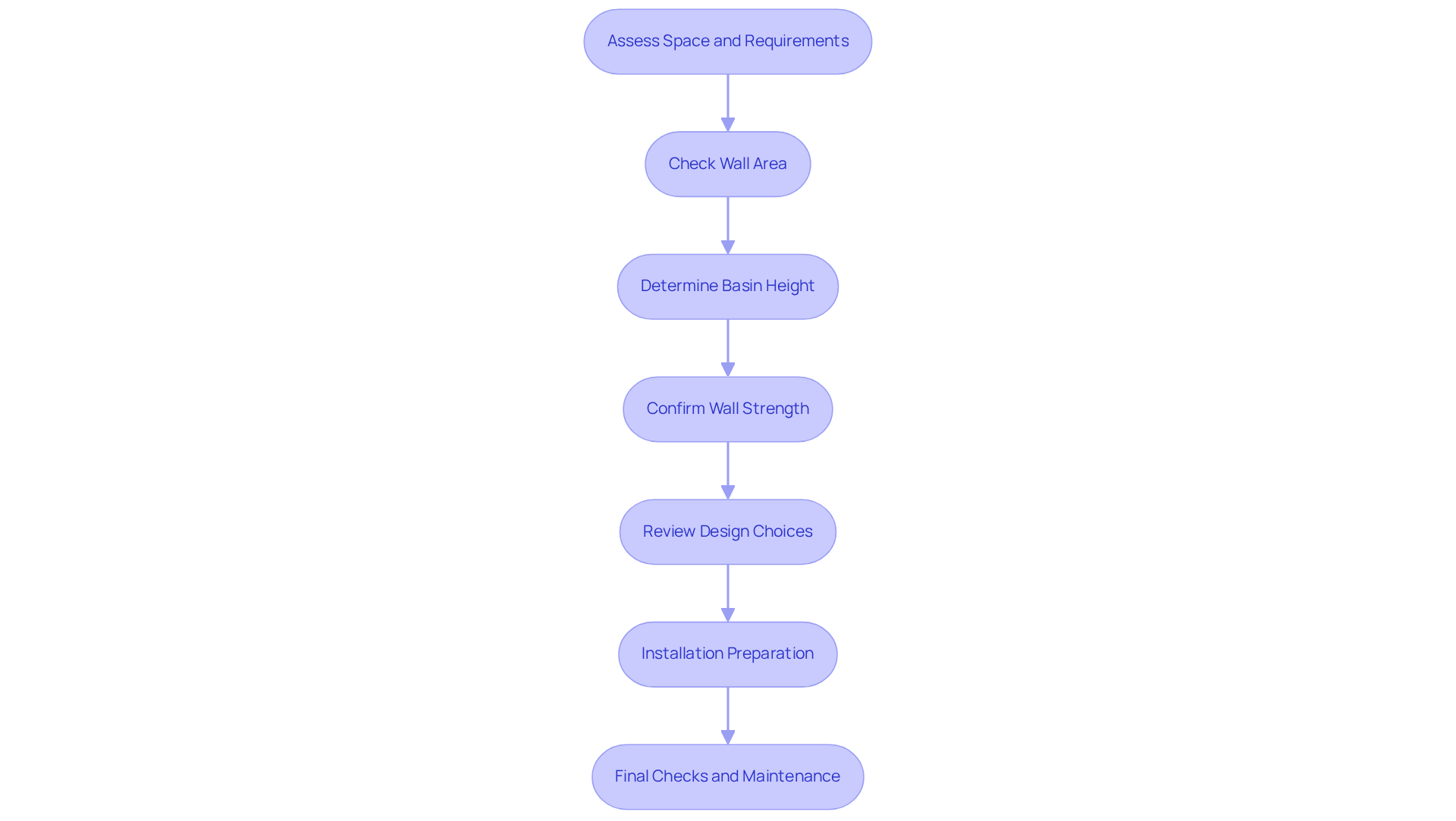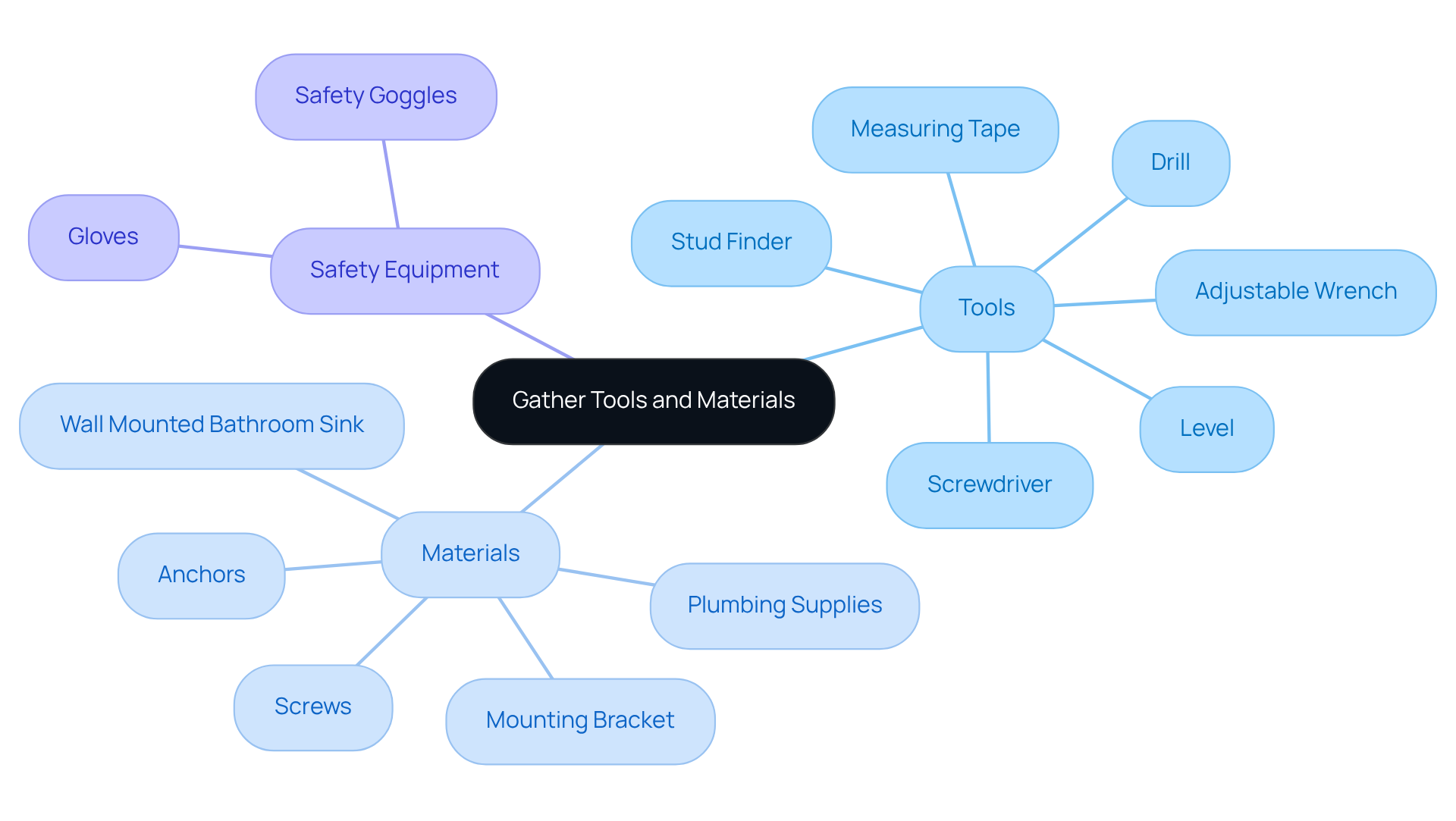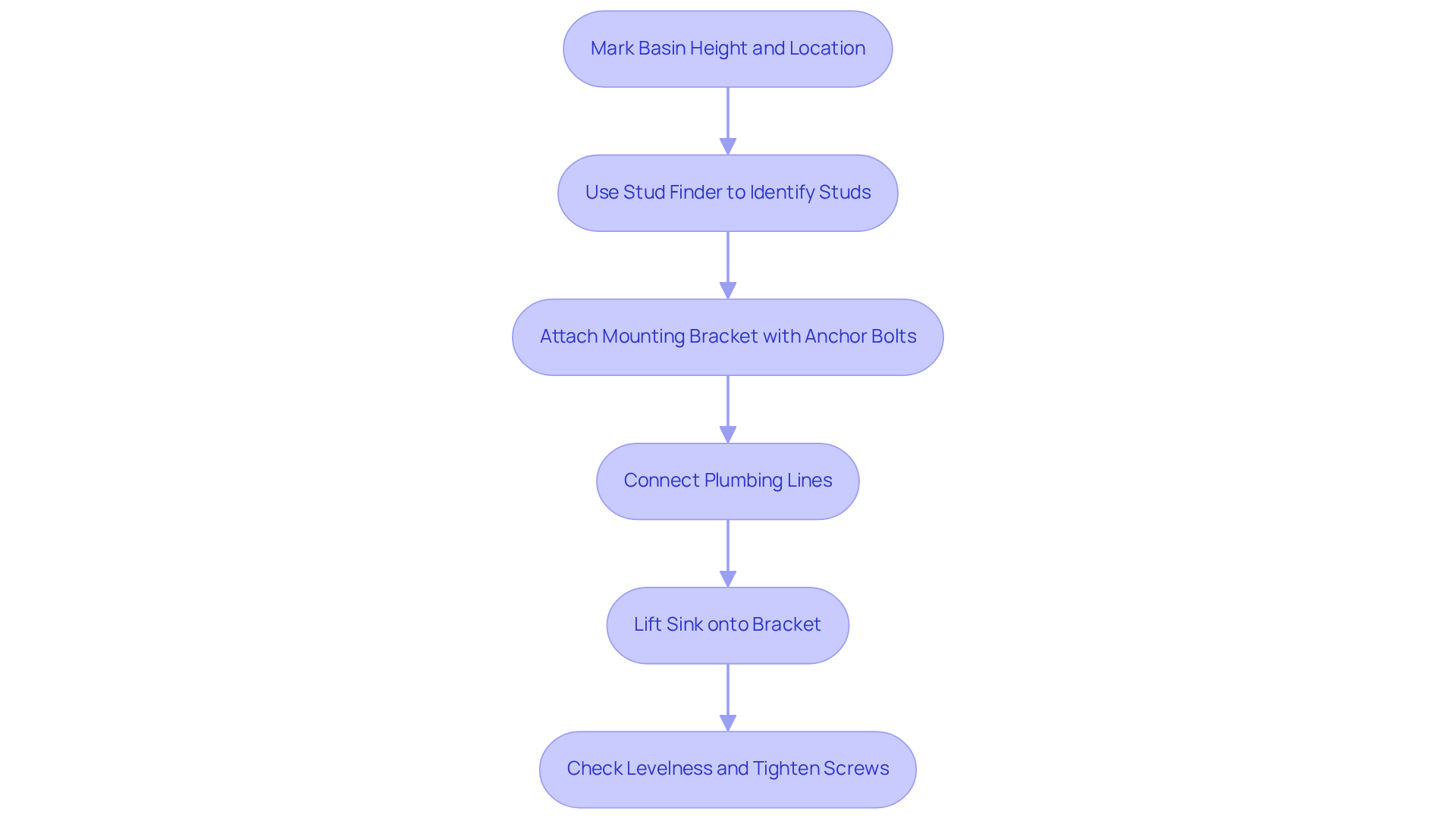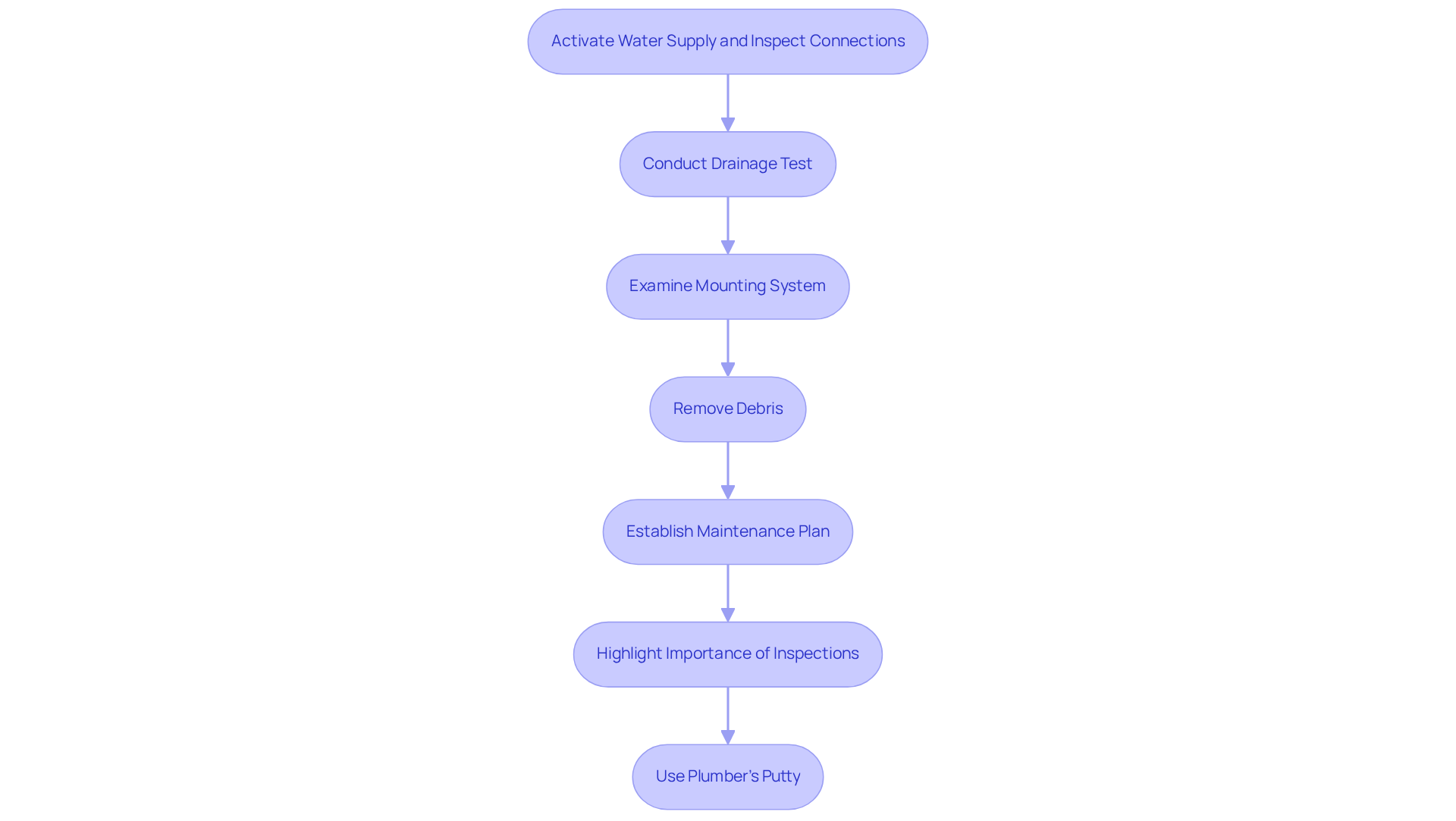Overview
Installing a wall-mounted bathroom sink requires a methodical approach that begins with assessing the space and requirements. This foundational step is crucial, as it sets the stage for gathering the necessary tools and materials, which are essential for a successful installation.
Following specific installation procedures is imperative; each step must be executed with precision to ensure the sink's stability, functionality, and longevity. Finally, conducting thorough final checks and maintenance cannot be overlooked.
Careful planning, proper tool selection, and strict adherence to installation guidelines are vital for preventing potential issues such as leaks and water damage. By following these essential steps, you can achieve a reliable and aesthetically pleasing installation that meets your needs.
Introduction
Installing a wall-mounted bathroom sink can significantly transform a space, providing both style and functionality while optimizing floor area. This article delineates four essential steps that guarantee a successful installation, from assessing the space to conducting final checks. However, it is crucial to note that many homeowners often overlook critical considerations that can result in costly mistakes or unsatisfactory outcomes.
What are the key elements that must not be ignored to achieve a seamless setup?
Assess Space and Requirements
Begin by assessing the wall area designated for the basin setup, ensuring there is ample space for the basin and any additional fittings, such as faucets or towel bars. This initial step is crucial for achieving a functional layout. Furthermore, check for existing plumbing and electrical lines that may influence the installation process. Proper planning in this regard can prevent costly adjustments later on.
Next, determine the optimal height for installing the basin, which typically ranges from 30 to 36 inches from the floor. This height can be adjusted based on user needs, accommodating children or individuals with limited mobility, thus ensuring comfort and accessibility. In addition, consider the style and size of the basin to ensure it harmonizes with the overall restroom design. A carefully selected basin can serve as a focal point, enhancing both functionality and aesthetics.
It is essential to confirm that the wall can adequately bear the load of the basin, which can fluctuate considerably. Attaching the basin to wall studs or reinforced backing is crucial to guarantee safety and stability. This consideration is particularly important in commercial settings where compliance with building codes is necessary. Adhere to the manufacturer's guidelines for setup to ensure appropriate operation and safety.
Successful restroom design projects, such as those completed for Padel Haus in New York and Lacuna Space in California, exemplify the effectiveness of these best practices in creating functional and visually appealing restroom environments. Regular cleaning and maintenance of wall-mounted sinks are also essential for keeping them in optimal condition.

Gather Tools and Materials
Collect essential tools for installation, including:
- A drill
- Level
- Stud finder
- Adjustable wrench
- Screwdriver
- Measuring tape
These tools are crucial for ensuring accurate measurements and secure fittings. Furthermore, gather necessary materials such as the wall mounted bathroom sink, along with:
- The mounting bracket
- Screws
- Anchors
- Plumbing supplies, including pipes and fittings
Selecting high-quality materials is vital for durability and functionality.
Ensure you have suitable safety equipment, including:
- Gloves
- Safety goggles
to protect yourself during the setup process. The usage of safety gear is recommended to prevent injuries, as improper handling can lead to accidents. In addition, consider the room layout and lifestyle before setup to anticipate potential issues. This step is crucial for ensuring that the basin fits well within the area and meets user needs.
Review the basin's assembly guide thoroughly for any specific requirements or additional tools that may be needed. Familiarizing yourself with the manufacturer's guidelines will facilitate a smoother installation process. Keep in mind that a wall mounted bathroom sink should be attached firmly to the surface to guarantee stability and safety, especially for ADA compliance, which mandates a minimum of 34 inches of clearance beneath the wall mounted bathroom sink for optimal use.

Follow Installation Steps
Begin by marking the preferred height of the basin, ideally between 30-36 inches from the floor, and its location on the surface with a pencil, ensuring compliance with user accessibility standards. Next, utilize a stud finder to accurately identify the studs within the structure, marking their positions to guarantee secure anchoring. Should the studs not align with the sink's mounting position, consider implementing standard 2 x 4s for wood blocking between the studs.
Proceed to attach the mounting bracket firmly to the surface using anchor bolts, ensuring it is level and securely fastened to the studs to avert any potential instability. In cases where the wall is tiled, employ a masonry drill bit for drilling holes. Subsequently, connect the plumbing lines to the basin, ensuring that all fittings are tightened adequately to prevent leaks, as improper connections can result in significant plumbing issues.
Carefully lift the sink onto the mounting bracket, securing it according to the manufacturer's instructions to ensure optimal stability. After setup, conduct a thorough check for levelness, making any necessary adjustments before fully tightening all screws to guarantee a professional finish.

Conduct Final Checks and Maintenance
- Activate the water supply and meticulously inspect all connections for any signs of leaks; properly tightening connections is crucial to preventing leaks.
- Conduct a drainage test to confirm that water flows smoothly without any blockages, ensuring proper drainage following setup.
- Examine the mounting system to ensure the basin is securely fastened and stable.
- Remove any debris left from the installation process in the basin and its surroundings.
- Establish a regular maintenance plan to maintain the basin in optimal condition, enabling quick resolution of any arising problems.
- Facility managers frequently highlight the importance of routine inspections. Leaks in newly installed wall mounted bathroom sinks can lead to considerable water damage if not addressed promptly. As noted by Brent Otsuka, a Manager of Interior Design at Fentress Architects, "Regular maintenance is key to preserving the integrity of installations and enhancing the overall restroom experience." Additionally, statistics show that five of the top ten most common maintenance issues are water-related, underscoring the importance of proactive maintenance. Furthermore, using plumber's putty as a sealant around the base of the wall mounted bathroom sink is recommended to create a watertight seal, further preventing leaks.

Conclusion
Installing a wall-mounted bathroom sink not only maximizes space but also enhances the aesthetic appeal of a restroom. By meticulously following the essential steps—from assessing the area and gathering the right tools to executing the installation and conducting thorough checks—a successful and secure setup can be achieved. Attention to detail during each phase ensures both functionality and safety, ultimately leading to a beautiful and practical bathroom environment.
Key insights underscore the importance of:
- Evaluating the wall's structural integrity
- Selecting appropriate materials
- Adhering to manufacturer guidelines for installation
Furthermore, regular maintenance and inspections are pivotal in preventing leaks and ensuring longevity. As emphasized, proactive measures in the installation process can save time and resources in the long run, avoiding common pitfalls that lead to costly repairs.
In conclusion, investing time and effort into properly installing a wall-mounted sink can significantly enhance both the utility and style of a bathroom. By embracing best practices and prioritizing maintenance, homeowners and facility managers alike can create spaces that are not only visually appealing but also functional and resilient. Embrace these steps to transform your restroom into a well-designed sanctuary that meets both aesthetic and practical needs.
Frequently Asked Questions
What is the first step in setting up a basin?
The first step is to assess the wall area designated for the basin setup, ensuring there is ample space for the basin and any additional fittings, such as faucets or towel bars.
Why is it important to check for existing plumbing and electrical lines?
Checking for existing plumbing and electrical lines is crucial as it may influence the installation process and proper planning can prevent costly adjustments later on.
What is the typical height range for installing a basin?
The typical height for installing a basin ranges from 30 to 36 inches from the floor, which can be adjusted based on user needs.
How can the height of the basin accommodate different users?
The height can be adjusted to accommodate children or individuals with limited mobility, ensuring comfort and accessibility.
What should be considered regarding the style and size of the basin?
The style and size of the basin should be considered to ensure it harmonizes with the overall restroom design and enhances both functionality and aesthetics.
What is necessary to ensure the wall can support the basin?
It is essential to confirm that the wall can adequately bear the load of the basin, which may require attaching the basin to wall studs or reinforced backing for safety and stability.
Why is it particularly important to adhere to safety guidelines in commercial settings?
In commercial settings, compliance with building codes is necessary, making adherence to safety guidelines crucial for installation.
Can you provide examples of successful restroom design projects?
Successful restroom design projects include those completed for Padel Haus in New York and Lacuna Space in California, which exemplify effective practices in creating functional and visually appealing restroom environments.
What maintenance is required for wall-mounted sinks?
Regular cleaning and maintenance of wall-mounted sinks are essential for keeping them in optimal condition.




